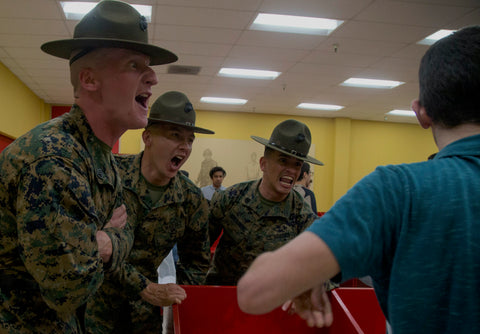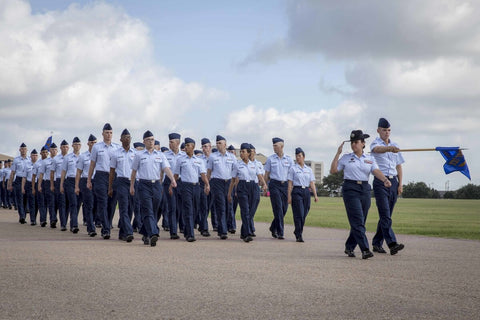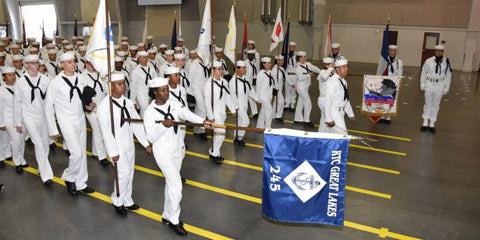The coronavirus has spread quickly over the planet in a matter of months. Worldwide, as of April 6, there are more than 1.1 million people infected with nearly 63,000 deaths reported according to the World Health Organization coronavirus map.
Given the U.S. military is spread across the planet and located in more than 100 countries, it comes as no surprise that 1,435 U.S. military members have coronavirus symptoms and have been infected by the virus as of April 6. The U.S. Army has 334 cases, Air Force has 281, Marines have 86, Navy has 431 and the National Guard has 303 cases.
That might seem like a lot of people, but allow me to offer some perspective. In 1918, the U.S. military was devastated by an influenza pandemic. World War I helped influenza gain traction in military training camps stateside and in Europe. Influenza traveled throughout various military camps and across the Atlantic. At the height of American military involvement in the war, influenza and pneumonia sickened 20 to 40 percent of U.S. Army and Navy personnel, according to a report from the National Institutes of Health titled The U.S. Military and the Influenza Pandemic of 1918-1919.
The infection rates were so high that they impacted induction and training and rendered hundreds of thousands of military personnel non-deployable. The good news is that we aren't anywhere near those numbers yet and the even better news is that unlike 1918 it seems as though military leaders are actually listening to military medical professionals and preventing the spread of COVID-19 by taking care of trainees.
In Europe, according to the report, 'Influenza attacked Allied and German armies alike, filling field hospitals and transport trains with weak, feverish men all along the Western Front.' In October 1918, the chief surgeon of allied forces reported that influenza and pneumonia outnumbered combat casualties. According to one report, 227,000 soldiers were hospitalized for battle wounds in 1918, but half again as many allied troops, 340,000, were hospitalized for influenza. 'The flu depleted and demoralized troops, and may have diverted military and political leaders from fighting the war to combating disease. It ultimately killed more American military personnel than did enemy machine guns and artillery.'
If you are attending military training or have a loved one currently in military training, I hope this post helps answer some questions. Remember, when in doubt, reach out to the chain of command for more information. For those of you who are wondering whether or not you will attend basic training, tech school or advanced individual training (AIT), or if you’re wondering how the coronavirus outbreak will impact your military training in the future, read on.
According to U.S. Army officials, U.S. Army trainees are screened two weeks before training and then screened again at four days before departure, three days before departure, and 24 hours before shipping to basic training. They are also examined by medical personnel upon arrival to the military entrance processing stations.
Last week, the Army reduced the number of trainees it is shipping each week by about 50 percent. Roughly 600 trainees were being sent to training to ensure proper distancing is maintained in barracks, classrooms and training environments. In a 60-person open-bay barracks, about one third of that number are housed in the bay so recruits can remain at a safe distance.

That said, the Army has started new transportation procedures for moving troops to AIT by moving hundreds of them in sterilized buses. Last week around 800 soldiers traveled in 32 cleansed buses from basic training at Fort Jackson, South Carolina to Fort Lee, Virginia while another group went from Fort Sill, Oklahoma to Fort Sam Houston in San Antonio, Texas. The Army placed only 25 soldiers on each 50-passenger bus to ensure social distancing was practiced.
Army recruits are also being isolated in new trainee groups and monitored for 14 days to keep them separate from other trainees who have been at basic training longer. This helps the Army react if a recruit tests positive since it minimizes the exposure group.
Army families are no longer allowed to attend graduation ceremonies. There are roughly 54,000 soldiers in training at the moment and on April 6, the Army decided to stop sending recruits to basic training for at least two weeks.
The U.S. Air Force has taken a different approach. A week ago, they temporarily stopped sending new recruits to basic training after four recruits became ill with the coronavirus in the service’s initial training program. The pause is giving the Air Force time to clean facilities and test instructors and trainees. It also buys the service some time to examine opening a second basic training site that can accommodate social distancing practices by having the regular basic trainee volume split between two locations.
Three of the Air Force recruits contracted the disease before basic training. The fourth individual likely contracted the disease from one of the others. The Air Force has now implemented restrictive personnel movements where groups of 40 recruits fly to Lackland Air Force Base together and are segregated from other individuals for two weeks.
But this week the Air Force has plans to send a small class of 60 recruits to Keesler Air Force Base, Miss. starting on April 7 for a shortened basic training of six weeks, reduced by two and a half weeks. If the intensive basic training works at Keesler, the Air Force may decide to keep the process in place during the crisis.

Pilot graduates and technical school graduates will travel to their regular duty stations as normally planned after graduation. Tech schools will continue to train because they are deemed mission essential, according to the Air Force. Airmen are not allowed to go on leave after graduations. They are only allowed to go directly to their assignments.
Last week the Air Force announced that it was moving up the graduation date for the U.S. Air Force Academy. The class of 2020 will have commencement on April 18 and the event will be live streamed. Guests are not allowed at any Air Force graduations.
The U.S. Marine Corps last week also stopped shipping new recruits to Recruit Depot Parris Island in South Carolina after more than 20 people there, recruits and drill instructors, tested positive for the coronavirus. The recruit shipment freeze will remain in place until at least mid-April.
The Marine Corps will continue shipping new recruits to Marine Corps Recruit Depot San Diego, the USMC’s other basic training base.
Recruits in training will practice social distancing in living, eating and training areas and like other services there will be no visitors at graduation ceremonies. Once Marines graduate from boot camp, they are being ordered to report directly to their follow-on training. Marines usually are granted a 10-day leave after completing boot camp. Families are precluded from attending graduation ceremonies.
The Navy decided last week it will not send new recruits to its boot camp in Great Lakes, Illinois after a recruit tested positive for coronavirus on March 28. All personnel at Great Lakes are being restricted in their movement and the recruit is receiving coronavirus treatment. Like its sister services, when recruits start shipping again to basic training the Navy will quarantine the recruits for two weeks before beginning training.

Trainees who are currently at Great Lakes are being broken down into smaller groups and the staff will remain on the base for at least 30 days to decrease the chance of spreading the coronavirus.
To date, the Army, Air Force, Navy and Marine Corps have all reported recruits who have tested positive for the coronavirus in the USA.
According to the Centers for Disease Control (CDC), coronavirus is spread when the virus that causes coronavirus is passed from person to person mainly through respiratory droplets produced when an infected person coughs or sneezes. These droplets can land in the mouths or noses of people who are nearby or possibly be inhaled into the lungs causing coronavirus transmission. Spread is more likely when people are in close contact with one another (within about 6 feet). You can get more information from the CDC coronavirus website.
What is the coronavirus? According to the CDC, a novel coronavirus is a new coronavirus that has not been previously identified. The virus causing coronavirus disease 2019 (COVID-19), is not the same as the coronaviruses that commonly circulate among humans and cause mild illness, like the common cold.
A diagnosis with coronavirus 229E, NL63, OC43, or HKU1 is not the same as a COVID-19 diagnosis. Patients with COVID-19 are evaluated and cared for differently than patients with a common coronavirus diagnosis. The WHO officially named the disease that is causing the 2019 novel coronavirus outbreak. It was first identified in Wuhan, China which is considered the coronavirus origin. The name of this disease is coronavirus disease 2019, abbreviated as COVID-19. In COVID-19, ‘CO’ stands for ‘corona,’ ‘VI’ for ‘virus,’ and ‘D’ for disease. The coronavirus incubation period is 1-14 days.
Please continue to follow developments of the COVID-19 outbreak by checking this blog for coronavirus updates. The one thing to remember is coronavirus deadly, but recovery rates are good and social distancing and washing your hands can make a huge difference.
Lastly, if you’re wondering about the spread of the coronavirus in the USA, and are tired of hearing about coronavirus news, it might be best to stick to reading official sources of information like the CDC and WHO rather than the news.
For example, recently I read that a dog had tested positive for COVID-19 and that a tiger at a zoo had tested positive as well. Yet according to the CDC, animals are not at risk of being infected. So, there is no way that someone can find the coronavirus in dogs, so the panic amongst pet owners is mostly fabricated.
Let’s keep our wits, practice precautions and stay healthy. Remember, improvise, adapt and overcome. One day at a time. Keep the perspective from WWI and realize that military leaders are doing all they can to protect our most valued commodity, the men and women of our armed forces.
Leave a comment
Please note: comments must be approved before they are published.